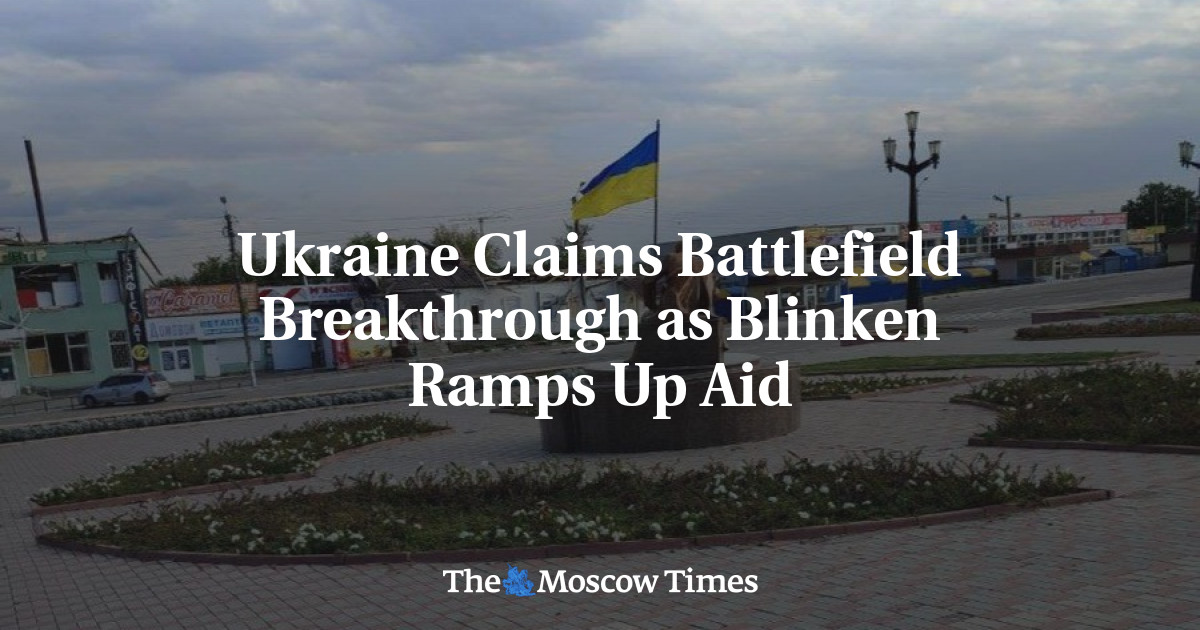
Ukraine on Thursday claimed a military breakthrough in its counter-offensive against Russian invaders as U.S. Secretary of State Antony Blinken, on a surprise visit to Kyiv, unveiled another $2.8 billion in military aid.
Ukraine said its forces made gains in the north, the south and the east, prying back land seized by Russia which had hoped for a swift victory when it attacked nearly seven months ago.
“Our heroes have already liberated dozens of settlements. And today this movement continued,” said Ukraine President Volodymyr Zelensky in an address to the nation.
“In total, more than a thousand square kilometers (nearly 400 square miles) have been liberated since Sept. 1,” he said shortly after announcing the recapture of Balakliya in the eastern Kharkiv region, a town which fell to Russian forces in early March.
In the area around Kharkiv, Ukraine’s second city, forces penetrated 50 kilometers (30 miles) beyond Russian lines and “liberated” more than 20 towns and villages, senior military official Oleksiy Gromov said.
Hoping to build on the momentum, Blinken secretly travelled to Kyiv for his second trip during the war, passing through dark hallways with sandbags in the sealed presidential compound to meet President Volodymyr Zelensky.
“It’s very early, but we are seeing clear and real progress on the ground,” Blinken said after spending more than two hours with Zelensky.
Blinken vowed the United States would keep up assistance “until the aggression ceases and Ukraine is fully sovereign” and that pressure on Russia would keep getting “heavier and heavier.”
“You have our word — and our track record,” he told Zelensky.
Zelensky, clad in his now signature military-green T-shirt, presented a state award to Blinken as he voiced gratitude for the “enormous support” of the United States.
The aid “is a guarantee that we can return our territories,” Zelensky said.
The latest package includes $675 million to be shipped shortly in arms, ammunition and supplies and another $1 billion in longer-term loans and grants for Ukraine to buy more US equipment.
The State Department also approved $1.2 billion for 18 other nations seen as facing threats from Russia including Baltic states, Moldova and Georgia which both have breakaway regions backed by Moscow.
A day after the United Nations said there were “credible reports” of Russia forcing Ukrainian children into its territory, Blinken started his trip by visiting toddlers injured in the war at a hospital.
In a room with toy trucks and alien figurines, he arrived with a basket of stuffed animals, announcing, “I brought some friends.”
“The spirit of your children sends a very strong message around the world,” he said.
‘Accountability’
Blinken later toured Irpin on the capital’s outskirts where the deputy mayor described indiscriminate attacks during Russia’s 25-day occupation at the start of the war and said there were 30,000 open cases related to war crimes.
“There has to be accountability for those who committed atrocities,” Blinken said.
In a coordinated display of resolve, President Joe Biden spoke by telephone with allied leaders about Ukraine and Defense Secretary Lloyd Austin met his counterparts at Ramstein air base in Germany.
“Now, we’re seeing the demonstrable success of our common efforts on the battlefield,” Austin said.
Amid Ukraine’s reports of gains, Russia also trumpeted battlefield successes, saying it hit five command posts and downed 13 drones on Thursday.
Addressing a forum in Moscow, Prime Minister Mikhail Mishustin said Russia had withstood Western sanctions over the war better than expected, estimating that GDP had fallen just over 1% year-on-year in the first six months of 2022.
Russia’s Central Bank expects a contraction of four to six percent for the year, while Blinken cited an estimate of an even steeper drop.
“Unprecedented sanctions were imposed on our country. But their initiators did not achieve their main objective. They failed to undermine our financial stability,” Mishustin said.
Allies pledge support
But as the war grinds on, both sides have increasingly been facing a crunch on military supplies with U.S. officials saying Russia was buying drones from Iran and large quantities of rocket and artillery shells from North Korea.
Speaking at Ramstein, top U.S. General Mark Milley said there was “significant consumption of munitions” by Ukraine that will need to be addressed by allies.
Norway offered 160 Hellfire missiles and night-vision equipment, Germany offered winter supplies and The Netherlands joined Germany with demining training.
The latest package by the United States — Ukraine’s largest supplier — includes 105mm howitzers, precision-guided GMLRS rockets and artillery ammunition.
It brings U.S. military aid to Ukraine since the invasion to $15.2 billion.
Among the most efficient weapons sent by Washington are the HIMAR multiple rocket launch systems, which are paired with GMLRS rockets that can reach targets up to 80 kilometers (50 miles) away.
But Kyiv is seeking ATACMS — precision-guided, medium range tactical missiles capable of striking 300 kilometers.
The United States has so far refused as it fears the missiles could land in Russian territory, sparking an even bigger conflict.
“The range of the HIMARS is sufficient to meet the needs of the Ukrainians as they are currently fighting,” Milley said.